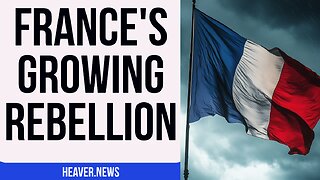Premium Only Content
![A book that is more advanced than science ][This book will surely surprise you](https://1a-1791.com/video/s8/1/q/0/0/t/q00tm.qR4e-small-A-book-that-is-more-advance.jpg)
A book that is more advanced than science ][This book will surely surprise you
#rumble
The holy book is believed to be first revealed in 609 C.E. Despite it appearing in a time when science held little value, one can find several scientific facts in this holy book.
The miracles of the book are layered and complicated. The holy book imparts knowledge on some of the most renowned miracles of science even before their discovery. The sacred book sheds information on the Theory of Relativity, Big Bang Theory, Genetics, Black Holes, and more.
Evidently, the holy book and science are not alienated from each other. In fact, the scientific discoveries in the book are described in the form of Surahs. However, some of the Surahs were not easy to believe till science became advanced enough to prove the existence of such phenomena.
Today, it is safe to say that complex phenomena are simply mentioned in the book, and science is a mere proof of the book’s information.
The mention of certain scientific inquiries in the holy book that were not known 14 centuries ago is indeed noteworthy. This vlog features a compilation of nine scientific facts in the Book.
Number 1. The Big Bang Theory in this book۔
The theory of the origin of the universe is one of the most noteworthy scientific things mentioned in this book. Until 100 years ago, it was believed that the universe has no creator and has always existed.
But Albert Einstein, during his field equations study, challenged this belief when he presented the theory that the universe is an expanding force that is growing like a balloon.
Later, a mathematician and Belgian priest proposed that this expansion must have begun from an initial and dense point.
A holy book that came into existence 1,300 years before the Big Bang theory came into existence describes this idea in detail.
It is said in this text, "Did not the disbelievers see that the heavens and the earth were a closed enclosure (ratqan), then We opened them" (21:31).
The word ratkan used in the text refers to darkness and closure. This is exactly what the universe looked like before the Big Bang.
2. The Big Crunch Theory in this book
The Big Crunch Theory that predicts how the universe will end is another scientific thing the book details. The theory, based on Einstein's theory of general relativity, talks about how the universe that began with the Big Bang will eventually collapse as a result.
This is a hypothetical scenario that details the fate of the universe and explains that the expansion will eventually reverse at some point in time and the universe will collapse.
This book mentions this event in verse 21:105 where it says, “Remember the Day when We will roll up the heavens as a scribe rolls up a scroll.” Islamic The description provided in the scriptures resembles the scenario that has been confirmed by many physicists around the world.
3. Oceanic Division mentions
The meeting of two oceans is called a confluence. When two oceans meet, their waters retain their individual characteristics such as temperature, color and density.
At a point of collision, one can see two different reservoirs running side by side. Although this discovery is recent, the book informs readers of this event in its passage of 55:19-20.
The book states the scientific fact that "he released two seas, meeting between them, a barrier [so] neither of them could cross."
4. Embryology in this book
Embryology is a branch of biology concerned with the study of fertilization and embryo development. The central text, at one point, talks about embryology and states a significant scientific fact in this book.
It says, “We created man from an extract of clay. Then we made him as a drop in a place of settlement, firmly fixed. Then we made the drop into an Alaqah (blood clot), then we made the Alaqah into a Mudghah…” (23:12-14).
Here the word ‘Alaqah’ can be defined as a leech, blood clot, or something suspended in the air. According to science, a foetus gets nutrients and oxygen from the mother. In this sense, it is not unlike a leech that sucks blood.
Also, in the early stages, the foetus stays stationary and the blood does not flow, which renders it similar to a blood clot. Lastly, in the womb, the baby hangs from the uterus wall by the placenta and lies suspended.
-
 LIVE
LIVE
Right Side Broadcasting Network
5 hours agoLIVE: White House Press Secretary Karoline Leavitt Holds a Press Briefing - 8/19/25
5,686 watching -
 1:03:48
1:03:48
Timcast
2 hours agoGavin Newsom SURGES In Polls, COPIES Trump's Style
99.6K58 -
 4:37
4:37
Michael Heaver
7 hours agoBusted France Faces UPRISING
383 -
 10:45
10:45
Dr. Nick Zyrowski
1 day agoDoctors Got It Wrong! This Causes of Obesity - NOT Sugar
5.7K6 -
 LIVE
LIVE
The Charlie Kirk Show
1 hour agoSummit Aftermath + America's Energy Revolution + Where Russiagate Will Lead | Wright, Solomon
3,683 watching -
 2:00:15
2:00:15
Steven Crowder
4 hours agoTrump's Huge Meeting Shocks the World & the Media is Dumbfounded
246K171 -
 LIVE
LIVE
Viss
1 hour ago🔴LIVE - How to Consistently Win in PUBG!
111 watching -
 LIVE
LIVE
GloryJean
3 hours agoSniping & Dominating Solos 🖱️ 6.7 K/D
23 watching -
 1:40:15
1:40:15
Nikko Ortiz
3 hours agoLive - Gun Shot And Gun Fails
31.1K5 -
 1:02:10
1:02:10
VINCE
5 hours agoWhat Just Happened At The White House? | Episode 106 - 08/19/25
193K249